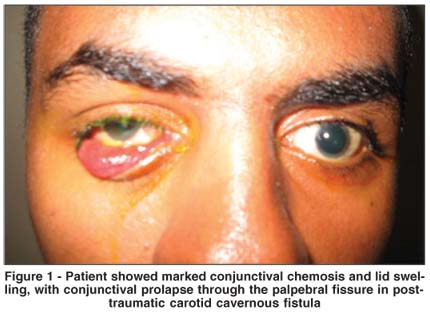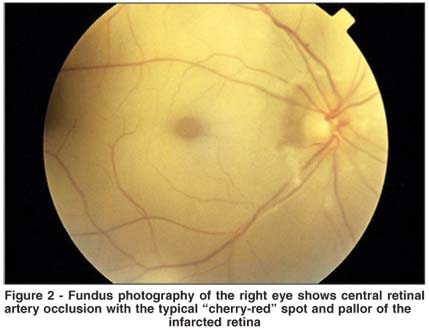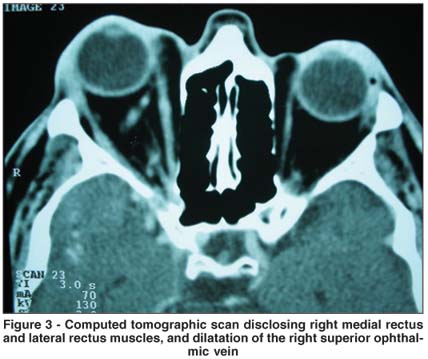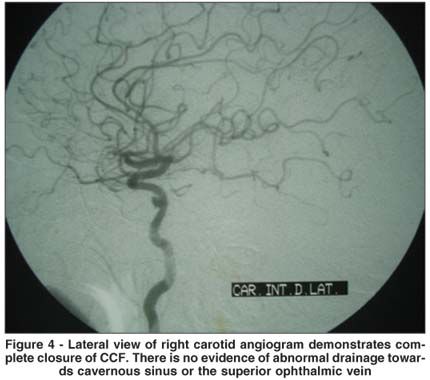

Paulo de Tarso Ponte Pierre Filho1; Flavio Mac Cord Medina3; Fabrício Kafury Pereira Rodrigues4; Clayton Rocha Lara Carrera4
DOI: 10.1590/S0004-27492007000500026
ABSTRACT
Carotid cavernous fistulas are a rare entity occurring as result of head trauma and also spontaneously. The authors report a rare case of central retinal artery occlusion complicating traumatic carotid-cavernous fistula, resulting in severe visual acuity loss. Spontaneous closure of the fistula was observed. The possible mechanisms responsible for this complication are discussed.
Keywords: Retinal artery occlusion; Carotid-cavernous sinus fistula; Angiography; Visual acuity; Case reports
RESUMO
Fístulas carótido-cavernosas são raras e ocorrem como resultado de trauma cefálico e também espontaneamente. Os autores relatam um caso raro de oclusão de artéria central da retina complicando fístula carótido-cavernosa traumática, resultando em perda grave da acuidade visual. Fechamento espontâneo da fístula foi observado. Os possíveis mecanismos responsáveis por esta complicação são discutidos.
Descritores: Fístula carotídeo-cavernosa; Oclusão da artéria retiniana; Angiografia; Acuidade visual; Relatos de casos
CASE REPORTS
Central retinal artery occlusion associated with traumatic carotid cavernous fistula: case report
Oclusão de artéria central da retina associada com fístula carótido-cavernosa traumática: relato de caso
Paulo de Tarso Ponte Pierre FilhoI; Flavio Mac Cord MedinaII; Fabrício Kafury Pereira RodriguesIII; Clayton Rocha Lara CarreraIII
IProfessor da Disciplina de Oftalmologia da Faculdade de Medicina de Sobral - UFC. Chefe do Setor de Glaucoma da Santa Casa de Sobral - Sobral (CE) - Brasil
IIPós-Graduando do Setor de Retina da Universidade Estadual de Campinas - UNICAMP - Campinas (SP) - Brasil
IIIResidente de Oftalmologia da UNICAMP - Campinas (SP) - Brasil
ABSTRACT
Carotid cavernous fistulas are a rare entity occurring as result of head trauma and also spontaneously. The authors report a rare case of central retinal artery occlusion complicating traumatic carotid-cavernous fistula, resulting in severe visual acuity loss. Spontaneous closure of the fistula was observed. The possible mechanisms responsible for this complication are discussed.
Keywords: Retinal artery occlusion/complications; Carotid-cavernous sinus fistula/etiology; Angiography; Visual acuity; Case reports [Publication type]
RESUMO
Fístulas carótido-cavernosas são raras e ocorrem como resultado de trauma cefálico e também espontaneamente. Os autores relatam um caso raro de oclusão de artéria central da retina complicando fístula carótido-cavernosa traumática, resultando em perda grave da acuidade visual. Fechamento espontâneo da fístula foi observado. Os possíveis mecanismos responsáveis por esta complicação são discutidos.
Descritores: Fístula carotídeo-cavernosa/complicações; Oclusão da artéria retiniana/etiologia; Angiografia; Acuidade visual; Relatos de casos [Tipo de publicação]
INTRODUCTION
Carotid cavernous fistulas (CCFs) and retinal vascular occlusions are fairly common entities in ophthalmic practice, but their occurrence together, especially that of a central retinal artery occlusion (CRAO) with CCF, is very rare. To the best of our knowledge, there is only one previous mention of a CRAO in a case of traumatic direct CCF and one mention in a case of spontaneous CCF(1-2). We herein describe a case of CRAO complicating a traumatic CCF leading to severe visual acuity loss.
CASE REPORT
A 28-year-old man came to the ophthalmology clinic because a sudden painless loss of vision in his right eye. He reported a 1-month history of progressive redness, diplopia, tinnitus and abnormal protusion of the right eye. He had suffered a severe blunt head injury after falling from a truck 2 months before symptoms started, and stayed in the Intensive Therapy Unit (ITU) for two weeks. The patient was in good medical condition and denied any history of diabetes mellitus, thyroid disease, hypertension, or heart disease.
On examination, his visual acuity was hand motions in the right and 20/25 in the left eye. The right eye showed dilated episcleral vessels, lid swelling, conjunctival injection, chemosis, and 3-mm proptosis (Figure 1). Its motility was restricted in all directions. Intraocular pressure was normal, anterior chamber was deep, and the angle was open. A relative afferent pupillary defect was noted. Fundus examination showed evidence of CRAO with a diffuse pallor and cherry-red spot at the macula (Figure 2). Fluorescein angiography revealed a prolonged arm-to-retina circulation time of more than 1 minute, which was also compatible with the diagnosis of CRAO. The examination of the left eye was unremarkable. Hematological work-up was normal. A computed tomographic scan disclosed an enlarged right superior ophthalmic vein and thickening of extraocular muscles in the right eye (Figure 3). No abnormalities were demonstrated in the left orbit. Carotid angiography was performed once treatment was planned, and spontaneous closure of the fistula was noted (Figure 4). The patient's clinical findings improved gradually over the subsequent two months, however, no significant improvement in right eye vision was obtained. Excessive tarsal conjunctiva was excised with good cosmetic result.




DISCUSSION
Clinical findings and radiographic aspects described are consistent with CCF. A CCF is an abnormal communication between a branch of the carotid artery and the cavernous sinus(1-2). The pressure gradient causes blood to flow into the veins, thus resulting in congestive features(1-2). Trauma is the most common cause of CCF although 25 percent of causes are non-traumatic(2). Traumatic causes include head injury, as well as iatrogenic causes including complications of carotid endarterectomy and percutaneous retrogasserian procedures(2). Carotid cavernous sinus fistulas can be divided into two types, high flow and low flow. The high-flow fistula is commonly caused by direct injury of the intracavernous carotid artery mostly due to trauma(3).
Some authors classified CCFs into four angiographic categories. Type A fistulas are direct communications between the internal carotid artery and the cavernous sinus. Types B, C, and D are indirect (dural) shunts because fistulas to the cavernous sinus arise from dural arteries and not directly from the internal carotid artery. CCFs, characterized by direct flow into the cavernous sinus from the intracavernous carotid artery, are of the high-flow type; these usually are traumatic and therefore most often diagnosed in young men as in our case(3).
Carotid cavernous fistulas have been a well-established cause of visual impairment and ocular morbidity. The initial presentation can be a pulsatile exophthalmos, orbital bruit, chemosis, or visual disturbances. Visual deterioration caused by open angle glaucoma secondary to raised episcleral pressure is the most common ocular problem(2). This may be difficult to treat because most glaucoma medications only reduce the gap between intraocular pressure and episcleral venous pressure. As the episcleral venous pressure elevates in CCSF, it is very difficult to reduce intraocular pressure medically(2-5). There is also the potential for rubeosis, ischemic retinopathy, central retinal vein occlusion, optic neuropathy, or corneal problems secondary to exposure(1-2,4-7).
Spontaneous occlusions of traumatic CCF are rare(8-12). Carotid angiography can play an important role. It is thought that formation of the thrombus is induced due to vascular contraction caused by the contrast medium, or due to a decrease in blood pressure during anesthesia(7-8). The possibility that a dissecting aneurysm formed in the cavernous portion of the internal carotid artery was obliterated has also been suggested(8).
The spontaneous resolution with thrombosis of the fistula caused improvement of symptoms. Unfortunately, the patient developed CRAO. The chronic red eye in these patients frequently is misdiagnosed on initial evaluation as chronic conjunctivitis, thyroid ophthalmopathy, or orbital pseudotumor, resulting in inappropriate treatment for prolonged periods of time. A direct carotid-cavernous fistula should be suspected in any patient who develops a red eye with chemosis and exophthalmus, especially after head trauma, as in this case.
Blunt trauma, venous congestion and thrombosis of the fistula were the possible predisposing factors for CRAO(1). It is suggested that excessively high pressure in the central retinal artery produced by elevation of pressure in the cavernous sinus, caused the arterial pressure in the retina to have the retinal circulation obstructed and it was responsible for the progression from stasis retinopathy to central retinal artery occlusion. Although the exact pathogenesis of such an obstruction was not completely discernible in our case, it is important to consider CRAO as a significant complication of traumatic CCF. Although traumatic CCFs may undergo spontaneous resolution, they often require treatment. Early recognition and intervention is important in the management of these patients.
REFERENCES
1. Pillai GS, Ghose S, Singh N, Garodia VK, Puthassery R, Manjunatha NP. Central retinal artery occlusion in dural carotid cavernous fistula. Retina. 2002;22(4):493-4.
2. Keltner JL, Satterfield D, Dublin AB, Lee BC. Dural and carotid cavernous sinus fistulas. Diagnosis, management, and complications. Ophthalmology. 1987;94(12):1585-600.
3. Barrow DL, Spector RH, Braun IF, Landman JA, Tindall SC, Tindall GT. Classification and treatment of spontaneous carotid-cavernous sinus fistulae. J Neurosurg. 1985;62(2):248-56.
4. Palestine AG, Younge BR, Piepgras DG. Visual prognosis in carotid cavernous fistula. Arch Ophthalmol. 1981;99(9):1600-3.
5. Keltner JL, Gittinger JW Jr, Miller NR, Burder RM. A red eye and high intraocular pressure. Surv Ophthalmol. 1986;31(5):328-36.
6. Pollock S, Miller NR. Central retinal vein occlusion complicating spontaneous carotid cavernous fistula. Arch Ophthalmol. 1986;104(3):331.
7. Costa VP, Narimatsu AP, Goldbaum M, Rodrigues-Alves CA. Fístulas carótido-cavernosas: descrição de quatro casos e revisão de literatura. Rev Bras Oftalmol. 1993;52(5):23-9.
8. van der Drift JH, Sparling CM, van den Berg D, Magnus O. Spontaneous occlusion of a carotid-cavernous shunt. Neurology. 1967;17(2):187-93.
9. Isfort A. [Spontaneous healing of a traumatic carotid artery-cavernous sinus fistula in a child during angiography]. Klin Monatsbl Augenheilkd. 1967;150 (6):821-7. German.
10. Parsons TC, Guller EJ, Wolff HG, Dunbar HS. Cerebral angiography in carotid cavernous communications. Neurology. 1954;4(1):65-8.
11. Potter JM. Carotid-cavernous fistulas, five cases with "spontaneous" recovery. Br Med J. 1954;2(4891):786-8.
12. Colli BO, Assirati Jr JA, Machado HR. Tratamento cirúrgico da fístula carótido-cavernosa. Arq Bras Neurocir. 1993;12(4):245-54.
 Endereço para correspondência:
Endereço para correspondência:
Paulo Pierre Filho
Rua Dr. João do Monte, 990
Sobral (CE) - CEP 62010-220
E-mail: [email protected]
Recebido para publicação em 18.09.2006
Última versão recebida em 26.02.2007
Aprovação em 01.03.2007
Nota Editorial: Depois de concluída a análise do artigo sob sigilo editorial e com a anuência do Dr. Haroldo Vieira de Moraes Jr. sobre a divulgação de seu nome como revisor, agradecemos sua participação neste processo.
Trabalho realizado no Departamento de Oftalmologia da Universidade Estadual de Campinas - UNICAMP - Campinas (SP) - Brasil.